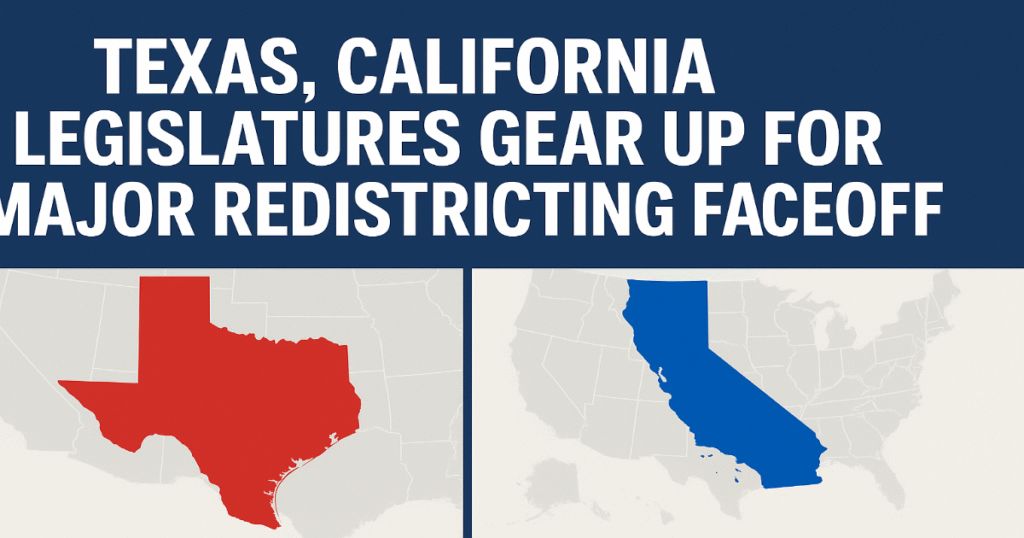
House Democratic Leader Hakeem Jeffries escalated the political fight over redistricting on Sunday, accusing former President Donald Trump and his Republican allies of attempting to “steal” the upcoming midterm elections through partisan map-drawing. But even as Jeffries pledged Democrats would push back nationwide, he dodged questions on whether New York would embrace the same tactics.
Appearing on CNN’s State of the Union, Jeffries framed the redistricting showdown in Texas as nothing less than a direct assault on democracy. “House Democrats are going to respond from coast to coast and at all points in between to ensure that Donald Trump cannot steal the midterm elections,” Jeffries declared, striking a defiant tone.
The remarks set off a storm of commentary across the political world, highlighting the increasingly nationalized fight over how congressional districts are drawn—and how much power those maps carry in shaping the balance of Congress.
Texas Sparks the Firestorm
At the center of the controversy is Texas, where Republicans, with Trump’s blessing, rushed through a new congressional map during a special legislative session this summer.
The redrawn districts, critics say, were carefully engineered to cement GOP dominance for years to come. Analysts project the plan could hand Republicans as many as five additional seats in the U.S. House—a potentially decisive margin in an already closely divided chamber.
Civil rights groups have already signaled lawsuits, arguing the maps dilute minority voting power, particularly in rapidly growing urban and suburban regions around Houston, Dallas, and Austin. Texas Democrats, who staged legislative walkouts earlier this year in protest, claim the process was blatantly partisan.
“Donald Trump personally pushed for this map because he knows the GOP’s national prospects depend on Texas,” said one Democratic strategist familiar with the fight. “If Republicans can lock in these seats, they’ll have a built-in advantage heading into 2026 and beyond.”
Jeffries’ Balancing Act
Jeffries has emerged as one of the loudest voices criticizing the GOP’s maneuvers, casting Trump’s involvement as part of a broader strategy to manipulate electoral rules to his advantage. His language—accusing Trump of trying to “steal” the midterms—echoed his past criticisms of Trump’s efforts to overturn the 2020 election results.
But when CNN host Dana Bash pressed him on whether Democrats in New York, his home state, would respond in kind, Jeffries sidestepped. “There’s a plan to respond as appropriately in New York and in other parts of the country as the circumstances dictate,” he said, declining to offer specifics.
The non-answer underscored the delicate position Jeffries finds himself in. On one hand, he wants to paint Republicans as anti-democratic aggressors. On the other, his party is under growing pressure to take advantage of redistricting opportunities in blue states—moves that critics argue amount to hypocrisy.
California Goes on Offense
While Jeffries hedged on New York, Democrats in California are moving full steam ahead. Governor Gavin Newsom and state legislative leaders are preparing a ballot referendum that would allow a fresh round of redistricting aimed at clawing back Democratic seats.
California lost a seat after the 2020 census, and Republicans made modest gains in the last midterms. But with Trump-aligned maps reshaping Texas, Democrats in the Golden State argue they can’t afford to play by “gentleman’s rules” anymore.
“If Texas Republicans are going to bend the process to their will, California has no choice but to respond,” one state Democrat said bluntly.
Political analysts estimate California could potentially net up to five new Democratic-leaning districts under the plan—mirroring the gains Republicans hope to secure in Texas.
A Redistricting Arms Race
The developments in Texas and California have fed into what many observers describe as an escalating “arms race” over redistricting.
For years, both parties accused each other of manipulating maps, but technological advances and hyper-polarized politics have raised the stakes. Sophisticated data modeling now allows state lawmakers to draw districts with surgical precision, maximizing partisan advantage while minimizing the risk of legal challenges.
According to a Reuters analysis, only about three dozen House districts out of 435 remain truly competitive. The rest have been tilted heavily toward one party or the other, making primaries more decisive than general elections in many places.
The implications are enormous. If Trump’s allies succeed in securing long-term advantages in red states, and Democrats counter in blue states, the map of American politics could harden for a generation.
GOP Response: “Making It Fairer”
Republicans, unsurprisingly, reject the idea that they are trying to steal anything. Vice President J.D. Vance defended the Texas map in a recent interview, arguing the changes were about making representation “a little bit more fair.”
He accused Democrats of hypocrisy for criticizing GOP-drawn maps while exploring aggressive countermeasures in California, New York, and Illinois. “They want to rig the game in their states while denying us the right to represent voters in ours,” Vance said.
Republicans also point out that Democrats have historically engaged in gerrymandering of their own, citing examples in Maryland and Massachusetts.
New York’s Murky Path
Nowhere is the tension more obvious than in New York.
Democrats there already redrew congressional lines in 2024 after a court ruling allowed them to revisit a previous map. The changes helped the party reclaim several seats in suburban districts, including around Long Island and the Hudson Valley.
Governor Kathy Hochul, who previously resisted overtly partisan maps, recently suggested her patience is wearing thin. “I’m tired of fighting this fight with one hand tied behind my back,” she said last month, hinting she may be open to more aggressive tactics.
State lawmakers are also considering a constitutional amendment that would authorize redistricting before 2028. Officially, the amendment bans maps drawn for “partisan advantage.” But Republicans remain deeply skeptical.
Rep. Mike Lawler, a New York Republican, blasted Democrats’ rhetoric as disingenuous. “They cry foul when Texas redraws its lines, but they have no problem doing the exact same thing in New York,” Lawler said. “It’s pure hypocrisy.”
What’s at Stake in 2026
The battle over maps is not just a fight about process—it could decide control of Congress.
Republicans currently hold a slim 219–212 majority in the House. If Texas’s new map withstands legal challenges, the GOP could gain several additional seats. If Democrats respond successfully in California and New York, they could offset those losses—or even flip the chamber.
In a political environment where power often shifts on a handful of districts, redistricting may matter as much as candidate quality or campaign spending.
“The reality is, the fight for Congress in 2026 is being shaped right now—not by voters, but by cartographers and state legislators,” said Larry Sabato, director of the University of Virginia’s Center for Politics.
Democracy or Gamesmanship?
The broader question looming over the redistricting war is whether democracy itself is being undermined.
Critics argue that when both parties manipulate maps for partisan advantage, voters lose meaningful choices, and trust in elections erodes. “People already believe the system is rigged,” said Wendy Weiser of the Brennan Center for Justice. “Extreme gerrymandering only deepens that cynicism.”
Jeffries insists Democrats are not the ones undermining democracy, portraying their actions as defensive rather than opportunistic. “We didn’t start this fight,” he said. “But we’re not going to sit back and let Donald Trump and his enablers steal the midterms.”
The Road Ahead
With more than a year until Election Day 2026, the redistricting battles are far from settled. Courts will weigh in on the legality of Texas’s map. California voters will decide whether to authorize new lines. And New York Democrats must choose whether to embrace the tactics Jeffries declined to endorse publicly.
What’s clear is that the fight over congressional boundaries is no longer a dry, procedural debate. It has become a central front in America’s partisan wars—one that could shape the House of Representatives, and the future of U.S. politics, for decades to come.
Also Read: Sweltering Heat Wave Brings Record-High Temperatures, Wildfire Risks to States Across the West
Visit: Cheapest Sale

Hey I am Srimanta Pradhan brings 10 years of experience to News Broadcast and Marketing, specializing in effective communication.A specialized content writer with a decade of expertise crafting compelling narratives for News Broadcast and Marketing. Transforms complex information into engaging, impactful content.




















